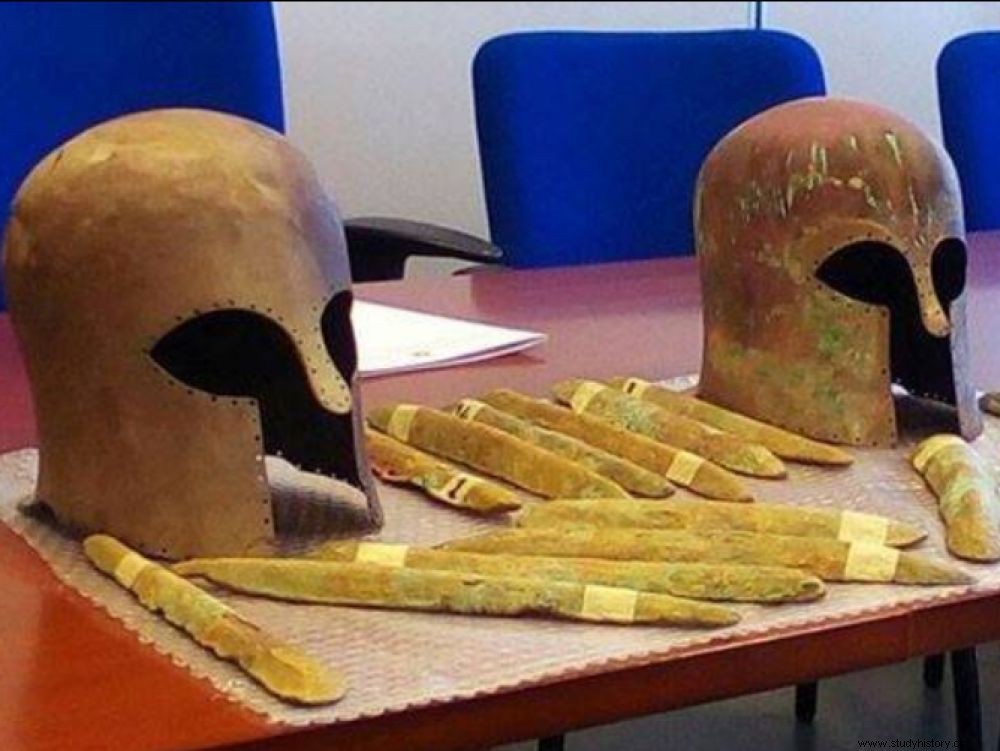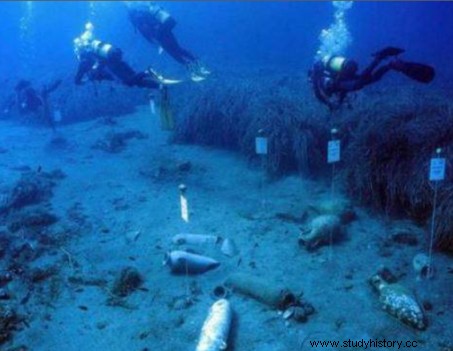Several orichalcum ingots, two Corinthian helmets and numerous amphoras have been unearthed on the Sicilian coast.

Orichalcum ingots and Corinthian helmets, recovered from a wreck located in the Gela region, off Sicily (Italy).
Two Corinthian helmets, amphoras and 47 ingots of orichalcum, this legendary metal associated with the myth of Atlantis described by the Greek philosopher Plato (V e century BC), have recently been recovered. They had been lying on the seabed for 2,500 years off Bulâla, not far from the ancient Greek colony of Gela, on the southern coast of Sicily (Italy). Dated from the end of the VII th -beginning VI e century before our era, they would come from the sector where 39 identical metal bars had already been raised in December 2014, to 300 m. sides. This time, it is a team of divers from the naval aeronautical department of the Palermo Financial Guard, associated with units of the Superintendency of the Sea, who deserve the credit for this miraculous catch. According to the descriptions transmitted to the Italian press by the prosecutor of Gela, Fernando Asaro, on February 10, 2017, these ingots weigh between 254gr and 1340gr and vary from 17cm to 32cm in length. The wooden planks alongside which they were located would signal the wreckage of a merchant ship.

The team of divers behind the discovery of orichalcum ingots and Corinthian helmets. © Corriere del Mezzogiorno
In his dialogues of "Timaeus and "Critias" , Plato mentions an imaginary continent, Atlantis, where the oreikhalkos ("mountain copper"), a more precious metal than gold, was used by the Atlanteans, the half-god, half-human inhabitants who populated the island before it sank into the sea. fable of the Greek philosopher which some have wanted to find a real echo in the destruction of Santorini, in the Aegean Sea, during the enormous volcanic eruption of 1630 BC, while others rather place Atlantis at the level Azores or near Gibraltar.

The wreck site where the orichalcum ingots were discovered. © Corriere del Mezzogiorno.
In Rome, the orichalcum more prosaically designated a brass intended for the striking of sesterces , currency in use during the reign of Augustus (from 23 BC) as indicated by the coins with a beautiful golden tone that numismatists also find used by other peoples, such as the Arverni, in Gaul in the second half from 1 st century before our era. Six specimens had thus been collected between 1861 and 1865 on the site of the battle of Alesia, including two in the name of their leader Vercingétorix. They were studied by Sylvia Nieto-Pelletier, deputy director of IRAMAT, at the Ernest-Babelon Center of the University of Orléans:"At that time, zinc as a metal was not yet known and the alloy of orichalcum then used was obtained by the process known as cementation:metallic copper in fusion was brought into contact with zinc ore and charcoal, to make the alloy thus formed acquire a yellow color very close to gold “, she explains in a publication*.
However, were the Greeks and Romans referring to the same metal when they spoke of orichalcum? This story, as already noted in 1973 in “Orichalcum and Brass "the historian of science and technology Robert Halleux, "is a problem of the history of techniques, which is clarified in the context of copper metallurgy ". In 2016, X-ray fluorescence spectrometric analyzes carried out on the first ingots reassembled by Dario Panetta, of the Genoese company Technologies for Quality, revealed that they were indeed composed of copper (80%) and zinc (20% ), with traces of lead, nickel and iron. An alloy therefore, and not a pure metal. But probably not enough to exhaust such a powerful myth!
* "Arverni Coins (Vercingetorix", in Orichalcum », by Silvia Nieto, in Numismatic Review, volume 160, 2004
